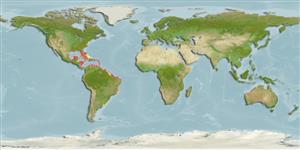Environment: milieu / climate zone / depth range / distribution range
पारिस्थितिकी
समुद्री प्रवाल-भित्ति संयुक्त; गहराई सीमा 0 - 12 m (Ref. 9710). Subtropical; 43°N - 37°S
Western Atlantic: Massachusetts (USA), Bermuda, and the Gulf of Mexico to Argentina.
आकार / वज़न / Age
Maturity: Lm ? range ? - ? cm
Max length : 50.0 cm TL पुल्लिंग / अलिंग; (Ref. 7251); common length : 35.0 cm TL पुल्लिंग / अलिंग; (Ref. 5217); अधिकतम प्रकाशित वज़न: 560.00 g (Ref. 40637)
पृष्ठीय रीढ़ (सम्पूर्ण): 7 - 8; पृष्ठीय सौफट रेज़ (सम्पूर्ण): 19-20; गुदा कांटा 2-3; ऐनल सौफट रेज़: 16 - 18. Dorsal and anal fins have very long, dark anterior lobes (Ref. 26938). Bluish silver on back, shading to silver on sides, with four narrow dark bars on upper of body (Ref. 13442).
Adults form schools in clear coastal areas, usually near coral formations (Ref. 5217). Juveniles common in clean sandy beaches (Ref. 5217). Adults feed on crustaceans, polychaete worms, insect pupae, mollusks and fishes (Ref. 9626). Between 1995 and 2000, at least 2 specimens were traded as aquarium fish at Fortaleza, Ceará (Ref. 49392).
Life cycle and mating behavior
परिपक्व अवधि | पुनरुत्पत्ति | मछलीऔ का अंडे देना | अंडे | Fecundity | लार्वा
Robins, C.R. and G.C. Ray, 1986. A field guide to Atlantic coast fishes of North America. Houghton Mifflin Company, Boston, U.S.A. 354 p. (Ref. 7251)
IUCN Red List Status (Ref. 130435)
Threat to humans
Reports of ciguatera poisoning (Ref. 30911)
Human uses
मात्स्यिकी: लघु वाणिज्य; जलीयकृषि: व्यापारिक; आखेट मत्स्य: हां
अधिक जानकारी
संदर्भजलीयकृषिजलीयकृषि रूपरेखाखींचआनुवंशिकीElectrophoresesहैरेटिबिलटीबीमारीप्रक्रमणNutrientsMass conversion
साधन
Special reports
Download XML
इंटरनेट स्रोत
Estimates based on models
Preferred temperature (Ref.
123201): 23.2 - 28.1, mean 27.3 °C (based on 851 cells).
Phylogenetic diversity index (Ref.
82804): PD
50 = 0.5000 [Uniqueness, from 0.5 = low to 2.0 = high].
Bayesian length-weight: a=0.01622 (0.00839 - 0.03134), b=2.83 (2.66 - 3.00), in cm total length, based on LWR estimates for this species & Genus-body shape (Ref.
93245).
Trophic level (Ref.
69278): 4.3 ±0.4 se; based on diet studies.
लौटाव (Ref.
120179): माध्यम, न्यूनतम जनसंख्या दुगनी होने का समय 1.4 - 4.4 वर्ष। (Assuming tm=2-4).
Fishing Vulnerability (Ref.
59153): Moderate vulnerability (40 of 100).
Nutrients (Ref.
124155): Calcium = 39.6 [14.6, 74.0] mg/100g; Iron = 0.785 [0.387, 1.762] mg/100g; Protein = 20.1 [18.1, 22.2] %; Omega3 = 0.158 [0.081, 0.315] g/100g; Selenium = 12 [5, 27] μg/100g; VitaminA = 40.7 [10.2, 151.3] μg/100g; Zinc = 0.509 [0.300, 0.825] mg/100g (wet weight);
